The AMD Radeon R9 290 Review
by Ryan Smith on November 5, 2013 12:01 AM EST- Posted in
- GPUs
- AMD
- Radeon
- Hawaii
- Radeon 200
Overclocking
Finally, let’s spend a bit of time looking at the overclocking prospects for the 290. Without any voltage adjustment capabilities and with AMD binning chips for clockspeeds and power consumption we’re not necessarily expecting a lot of headroom here, but none the less it’s worth checking out to see how much more we can squeeze out of the card.
Even though we’re officially limited to AMD’s Overdrive utility for the moment for overclocking, Overdrive offers a wide enough range of values that we shouldn’t have any problem maxing out the card. In fact we’ll be limited by the card first.
| Radeon R9 290 Overclocking | |||
| Reference Radeon R9 290 | |||
| Shipping Core Clock | 662MHz | ||
| Shipping Boost Clock | 947MHz | ||
| Shipping Memory Clock | 5GHz | ||
| Shipping Boost Voltage | ~1.18v | ||
| Overclock Core Clock | 790MHz | ||
| Overclock Boost Clock | 1075MHz | ||
| Overclock Memory Clock | 5.6GHz | ||
| Overclock Max Boost Voltage | ~1.18v | ||
Despite the lack of voltage control, when it comes to overclocking the 290 we were able to achieve solid overclocks on both the GPU and the memory. On a boost clock basis we were able to push the 290 from 947MHz to 1075MHz, an increase of 128MHz (14%). Meanwhile we were able to push the memory from 5GHz to 5.6GHz before artifacting set in, representing a 600MHz (12%) memory overclock. Being able to increase both clockspeeds to such a similar degree means that no matter what the video bottleneck is – be it GPU or memory – we should see some kind of performance increase out of overclocking.
On a side note, for overclocking the 290 we stuck with moderate increases to both the maximum fan speed and the PowerTune limit. In the case of the former we used a 65% maximum fan speed (which actually proved to be more than what’s necessary), while for the latter we went with a 20% increase in the PowerTune limit, as at this point in time we don’t have a good idea for what the safe power limits are for the reference 290/290X board. Though in either case only FurMark could push the overclocked card to its power limit, and nothing could push the card to its fan speed limit. Similarly we didn’t encounter any throttling issues with our overclocked settings, with every game (including CoH2) running at 1075MHz sustained.
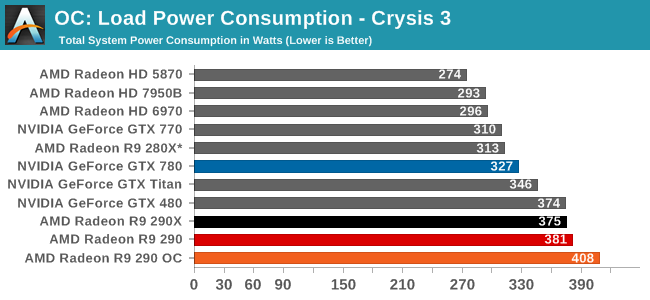
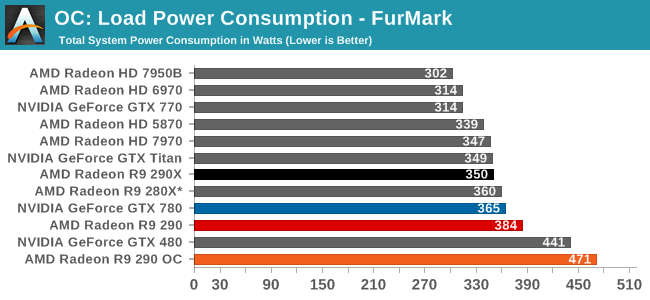
Taking a brief look at power, temp, and noise before jumping into our gaming performance results, we can see that overclocking the card has a measurable impact on power consumption under both Crysis 3 and FurMark. With Crysis 3 we’re clockspeed limited before we’re power limited, leading to an increase in power consumption of 27W, while under FurMark where we were power limited it’s a much more academic increase of 87W.
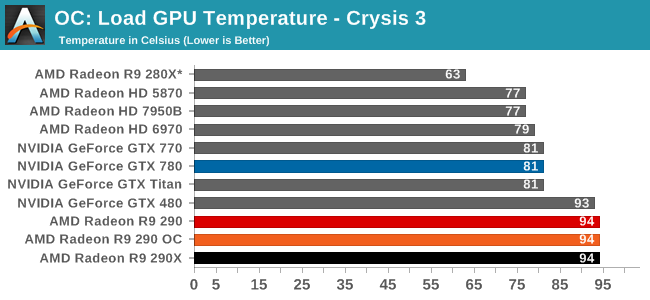
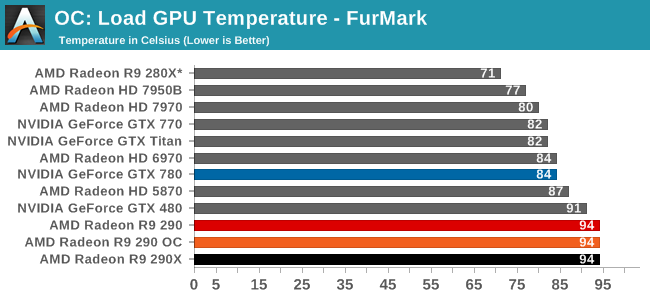
Since the 290 already ships at the highest temperate limit it allows – 95C – our sustained temperatures are unchanged even after overclocking.
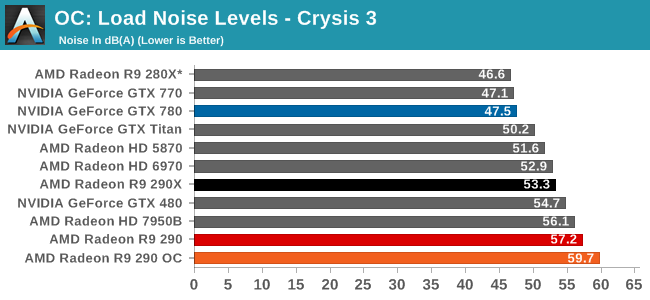
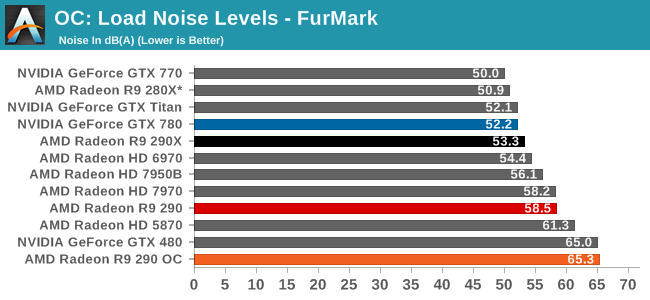
The 290 is already an unreasonably loud card at stock, and unfortunately the fan speed increases needed to handle the greater heat load from overclocking only make this worse. Under Crysis 3 we peaked at 59.7dB, or 49% fan speed. While under FurMark we peaked at 65.3dB, or 59% fan speed. For these noise levels to be bearable the 290 really needs to be fully isolated (e.g. in another room) or put under water, as otherwise 59.7dB sustained is immensely loud for a video card.
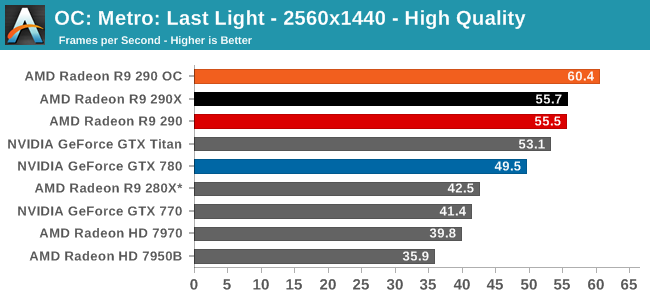
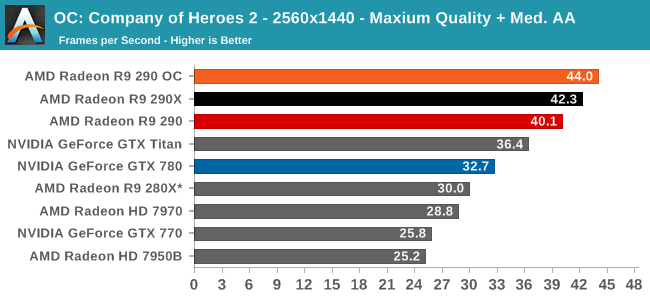
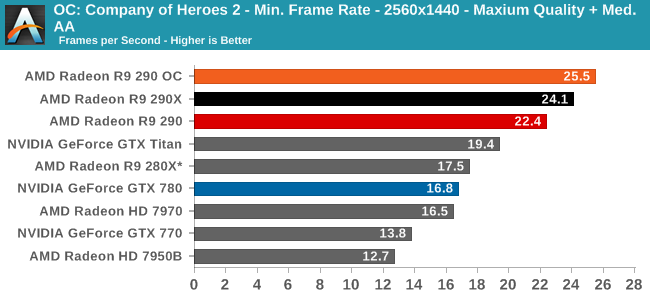
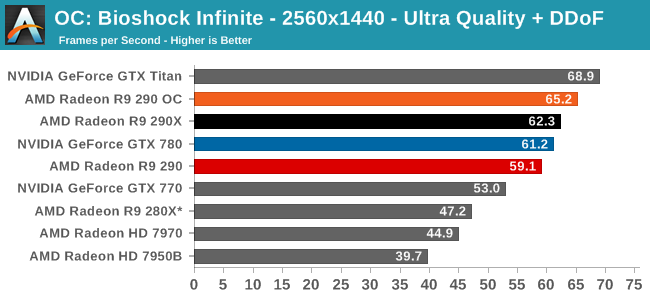
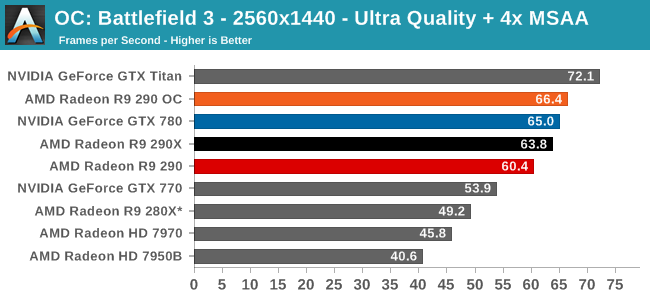
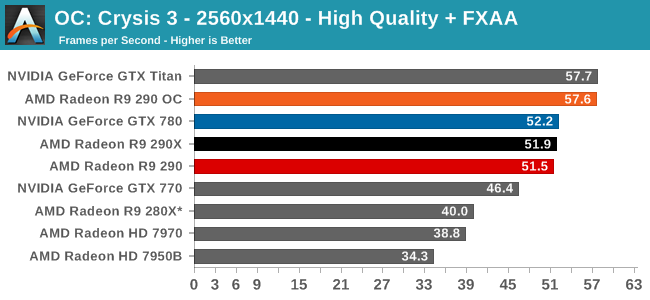
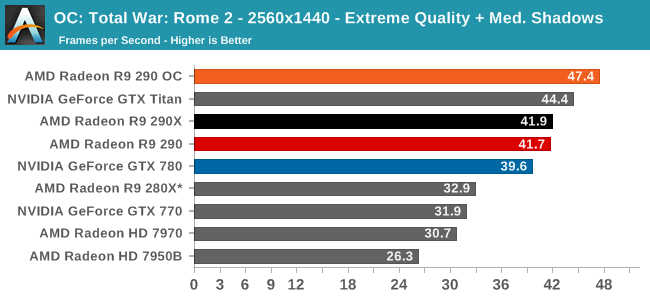
Finally getting to the matter of game performance, we’re seeing consistently strong scaling across every game in our collection. The specific performance increase depends on the game as always, but a 14% core overclock and 12% memory overclock has netted us anywhere between 9% in Metro up to the full 14% in Total War: Rome II. At this performance level the 290 OC exceeds the performance of any other single-GPU card at stock, and comes very close to delivering 60fps in every action game in our benchmark suite.










295 Comments
View All Comments
blank001 - Tuesday, November 5, 2013 - link
Intense review, but I think the custom cooler will make it a solid buy ultimately.Samus - Tuesday, November 5, 2013 - link
definitely needs a better cooler. ridiculous potential held back by an intel-esk cooler.piroroadkill - Tuesday, November 5, 2013 - link
*esqueRagnarKon - Tuesday, November 5, 2013 - link
Sold. I am very impressed.Such a dramatic decrease in price makes me feel like that both AMD and Nvidia were essentially ripping us off with the previous generations. I'd like to know what their profit margins were, and what they are now. Either way, I appreciate the seemingly competative pricing coming from AMD this time around.
$550 for 290X was a little outside my price range, but I can do $400. I shall be waiting patiently by my phone for until I get a notification that it is in stock.
BPM - Tuesday, November 5, 2013 - link
I think the profit margin for 290 is less than 290x percentage wise. We may have cheaper flagship amd next yearRagnarKon - Tuesday, November 5, 2013 - link
You are probably right. Still just leaves a bad taste in my mouth knowing that I paid so much for the previous generation, and that they are willing to cut launch prices but so much.I re-read the review after my head cooled down a bit and am now a little more concerned about the noise level. It isn't a deal-breaker for me, but it is a concern. I may have to wait for the non-reference coolers to come out before I take the plunge.
Ananke - Tuesday, November 5, 2013 - link
Noise level is LESS than 5850/5870. I had such card, it was pretty normal to me. It is at least twice less noise than 4870...Sandcat - Tuesday, November 5, 2013 - link
The 5850/70 didn't need to run their fans at 60%. In fact, at stock profiles, mine never went above 65c, unlike these furnaces.slickr - Tuesday, November 5, 2013 - link
Just wait 2 weeks for custom cooler cards and this card is a beast. I mean it will probably be even faster with a natural OC on custom cooler cards, so add 4-5% more performance on top of the current one and lower noise levels at $400 and you have yourself a winner.I'll be waiting 2 weeks(hopefully less) and getting one with custom cooler and hopefully factory OC. I mean right now it pretty much beats Titan in half the games, with a factory OC and better cooler it going to come close to beating Titan at almost all the games.
So wait two weeks like me and get a custom cooled 290, for $400 its an amazing choice, I might consider getting a GTX 780 though if Nvidia lowers its price to $400 as well, so with 3 free games at $400 it may be better worth, but as of now the 290 is the king.
DMCalloway - Tuesday, November 5, 2013 - link
You still have to dissipate the heat. Custom coolers are usually open design, so while it will be quieter all that heat is now going to be pumped into the case.